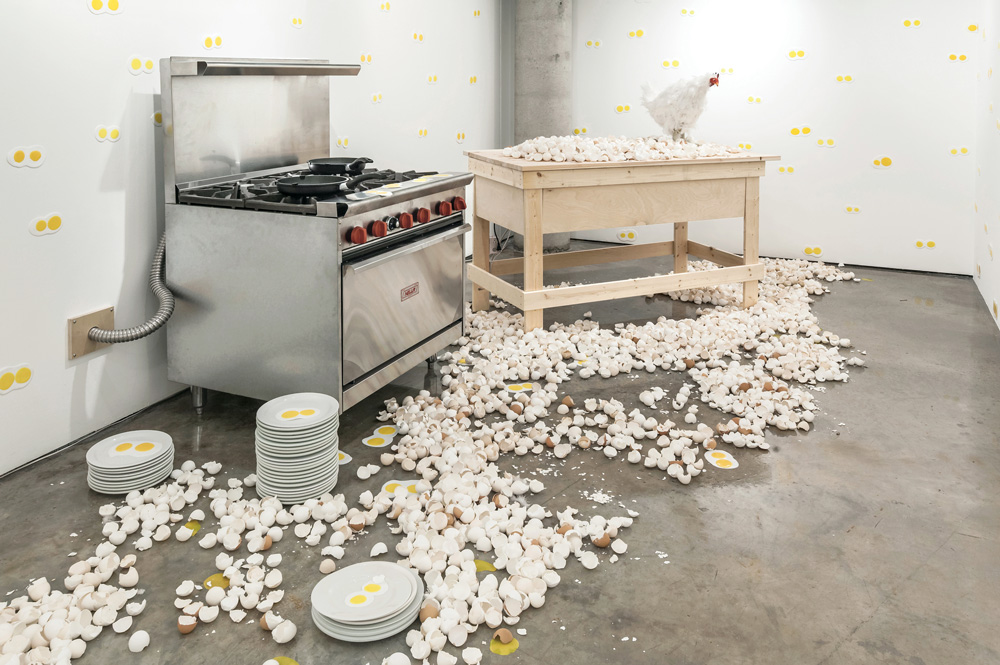As with so many of Rita McKeough’s ambitious, large-scale and labour-intensive performative installations, The Lion’s Share (2011–14) strategically yet playfully immerses its audience within a sensorially charged and intricately layered simulated environment—in this instance, within the inner workings of a bizarre faux diner.
Although the installation resembles a fast-food restaurant, the quirky handcrafted furnishings, wall decor and overall ambience are anything but predictable. The space reverberates with animal sounds—in the restaurant, the unnerving, aggressive roars of a lion, king of predators, are heard as he devours a large bone, and from the back-room kitchen, the panicked squawking and sobs of an overworked hen.
Square wooden tables balance precariously on whittled, spear-like legs; mechanized stick-utensils prod the food (synthetic fried eggs and hot dogs at every place setting); sculpted white tongues protrude from glasses of fake milk; and a large rectangular wooden fence reminiscent of a holding pen sits, buffet-style, on a white tablecloth—inside, a herd of hot dogs is surrounded by hot-dog droppings.
Clearly staged from the perspective of the animals that either produce or become the main items on the menu, the installation explores McDonald’s-ized consumption habits and the politics and ethics of industrialized food production.
But McKeough’s critique surfaces gently and sequentially, as if coaxed out from depths disguised as absurdity: the submerged tongues in the glasses of milk suggest a wet lick, a tactile connection to the food source; the brown wooden holding-pen enclosure containing hundreds of hot dogs functions as a caricature of the crowded and stressful conditions animals experience prior to arriving on our plates; and the mass of hot dogs and fried eggs throughout the installation are emblematic of the fast-food industry’s impact on North American diets.
The plight of animals subjected to automated farming is animated through exaggerated scenes: stabbed hot dogs are randomly skewered to the walls, food items are repeatedly poked by crude sticks, a bubbling tank of plastic cow eyeballs floating in a milky substance looms in the corner and, in the kitchen, in the middle of mounds of empty eggshells, a frazzled, mechanized hen laughs and shrieks uncontrollably, every few minutes succumbing to the demands of egg production, hysterically collapsing in a heap.
One cannot help but feel empathy for the chickens’ or hot dogs’ predicaments—the installation is premised on an affective engagement with performative scenes in which disturbingly anthropomorphic objects and innocent creatures give voice to a social phenomenon that requires closer scrutiny. Hanging on the diner’s walls, the cartoonish but worried faces of carrots mounted on oval plates appear as witnesses casting a critical gaze on the spectacle taking place; these in combination with the images of spiralling swallows falling from the sky create a sensation of foreboding that clouds the otherwise playful atmosphere.
Presented within an art gallery in the College of Agriculture and Bioresources on the University of Saskatchewan campus, McKeough’s proposition of examining unsustainable and industrialized food-production practices was particularly poignant.
This is a review from the Fall 2014 issue of Canadian Art. To read more from this issue, visit its table of contents.

 Installation view of Rita McKeough's The Lion's Share, 2011–14. Photo: Jane Edmunson.
Installation view of Rita McKeough's The Lion's Share, 2011–14. Photo: Jane Edmunson.







